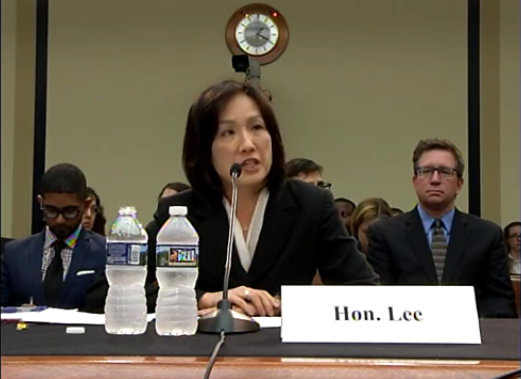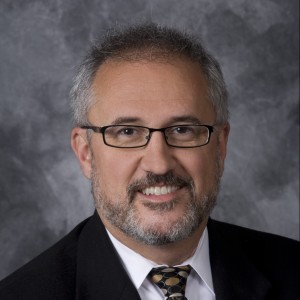USPTO Director Lee testifies before House Judiciary Committee
 On the afternoon of Tuesday, September 13th, the intellectual property subcommittee of the U.S. House of Representatives Judiciary Committee convened for a hearing on oversight of practices and procedures at the U.S. Patent and Trademark Office. The day’s sole panelist was USPTO director Michelle K. Lee. The day’s discussion focused on recent reports from federal governmental agencies regarding issues at the USPTO surrounding patent litigation as well as time and attendance abuses among USPTO examiners.
On the afternoon of Tuesday, September 13th, the intellectual property subcommittee of the U.S. House of Representatives Judiciary Committee convened for a hearing on oversight of practices and procedures at the U.S. Patent and Trademark Office. The day’s sole panelist was USPTO director Michelle K. Lee. The day’s discussion focused on recent reports from federal governmental agencies regarding issues at the USPTO surrounding patent litigation as well as time and attendance abuses among USPTO examiners.
A press release posted in advance of the hearing contained statements from both House Judiciary Committee chairman Bob Goodlatte (R-VA) and Courts, Intellectual Property, and the Internet subcommittee chairman Darrell Issa (R-CA) provided a good indication of the direction the hearing would take. Both statements reflected a wariness regarding timesheet abuses among USPTO employees. “The amount of wasted man-hours that could have been spent reducing the patent backlog is astounding, not to mention the millions of taxpayer dollars that were wasted paying USPTO employees for work they were not doing,” Goodlatte’s statement read. Issa added, “If the PTO can’t even guarantee sufficient oversight of its employees timecards, how can we be assured patent examiners aren’t just rubberstamping ideas without oversight as well?”
The concerns of both Congressmen stem from an examiner time and attendance report issued August 31st by the Office of the Inspector General (OIG) within the Department of Commerce. The Commerce Department’s OIG found 288,000 unsupported hours of work claimed by examiners over a 15-month period, which was equated to more than $18.3 million in potential waste. The OIG report also found multiple weak points in USPTO policy which limits the agency’s ability to detect fraud, including no requirement for teleworking examiners to log into computers during workdays as well as no requirement for workers with average or high performance ratings to provide supervisors with work schedules.
The methodology used during the OIG’s study on time and attendance abuse was also questioned by Congressman Jerrold Nadler (D-NY). Nadler’s prepared remarks noted that the unsupported work hours identified in the OIG’s report amounted to less than 2 percent of all hours worked by examiners during the 15-month period of the study. “In fact, the IG acknowledges that after the USPTO instituted certain reforms to its telework policy, six months into the study, the percentage of unsupported hours dropped to just 1.6%, an efficiency rate that most employers would boast about,” Nadler’s prepared remarks stated. “But, the IG buried this fact in a footnote deep in the report.”
“My team and I do not tolerate time and attendance abuse,” Lee told the subcommittee. While she did note that the USPTO had taken disciplinary actions against examiners that have abused time and attendance reports, such actions ranging from counseling to expulsion and repayment for hours not worked, she added that there was evidence that instances of time and attendance abuse were not widespread. She cited a report on the USPTO’s telework program issued by the National Academy of Public Administration (NAPA) in July 2015. The report found that “It would appear to be unlikely that [time and attendance] abuse is widespread or unique to teleworkers, and it does not appear to reflect the actions of the workforce as a whole.”
Alice Experts and the Return of Second Pair of Eyes to the PTO
 “I have not yet run into an Art Unit that does not have someone designated as an Alice expert,” explained JiNan Glasgow of Neopatents. “They won’t always tell you who it is, but they all say they have an Alice expert.”
“I have not yet run into an Art Unit that does not have someone designated as an Alice expert,” explained JiNan Glasgow of Neopatents. “They won’t always tell you who it is, but they all say they have an Alice expert.”
While discussing the importance of doing interviews in every single case, Glasgow explained that although it is not something that has been generally publicly disclosed by the Patent Office, “in every art unit examiners confirm that there is an examiner within the Art Unit who is the Alice expert and that examiners have said that even if they are ready to allow a case, nothing can be allowed without the approval of that Alice expert.” This applies to TC 3600 and beyond, according to Glasgow.
If what examiner after examiner has told Glasgow is correct, this means there is essentially a return to the so-called “second pair of eyes” review at the Patent Office.
08.18.16 | patent eligibility, Patent Issues, Patent Prosecution, USPTO | Gene Quinn
Patent Office gives examiners guidance in light of Enfish
 Recently, the United States Patent and Trademark Office (USPTO) sent a memo to the Examining Corps with information and instructions relating to the recent ruling in Enfish, LLC v. Microsoft Corp. by the United States Court of Appeals by the Federal Circuit. In Enfish, the Federal Circuit ruled that the software patent claims at issue were not abstract and were patent eligible. This marked the first time in 18 months, since the Court’s ruling in DDR Holdings in December 2014, that the Federal Circuit has found software patent claims to be patent eligible.
Recently, the United States Patent and Trademark Office (USPTO) sent a memo to the Examining Corps with information and instructions relating to the recent ruling in Enfish, LLC v. Microsoft Corp. by the United States Court of Appeals by the Federal Circuit. In Enfish, the Federal Circuit ruled that the software patent claims at issue were not abstract and were patent eligible. This marked the first time in 18 months, since the Court’s ruling in DDR Holdings in December 2014, that the Federal Circuit has found software patent claims to be patent eligible.
The USPTO memo was authored by Robert Bahr, who is Deputy Commissioner for Patent Examination Policy. As you would expect, it accurately explains the importance of the Federal Circuit ruling in Enfish. Bahr tells examiners that, based on the Federal Circuit ruling, they “may determine that a claim directed to improvements in computer-related technology is not directed to an abstract idea under Step 2A of the subject matter eligibility examination guidelines (and is thus patent eligible), without the need to analyze the additional elements under Step 2B.” (emphasis in the original) Bahr goes on to tell examiners that a claim that is “directed to an improvement to computer-related technology (e.g., computer functionality) is likely not similar to claims that have been previously identified as abstract by the courts.”
06.7.16 | CAFC, Patent Issues, posts, USPTO | Gene Quinn
PTAB denies to institute CBM citing Enfish v. Microsoft
 The Patent Trial and Appeal Board (PTAB) of the United States Patent and Trademark Office (USPTO) recently declined to institute a CBM review of U.S. Patent No. 6,006,227, owned by Mirror World Technologies, LLC. See Apple, Inc. et al v. Mirror World Technologies, LLC. The decision is significant not only because the PTAB refused to institute a covered business method review, but because the panel — Administrative Patent Judges Thomas Giannetti, David McKone, and Barbara Parvis — cited the Federal Circuit’s recent decision in Enfish v. Microsoft when they found that the challenged claims of the ‘227 patent were not abstract.
The Patent Trial and Appeal Board (PTAB) of the United States Patent and Trademark Office (USPTO) recently declined to institute a CBM review of U.S. Patent No. 6,006,227, owned by Mirror World Technologies, LLC. See Apple, Inc. et al v. Mirror World Technologies, LLC. The decision is significant not only because the PTAB refused to institute a covered business method review, but because the panel — Administrative Patent Judges Thomas Giannetti, David McKone, and Barbara Parvis — cited the Federal Circuit’s recent decision in Enfish v. Microsoft when they found that the challenged claims of the ‘227 patent were not abstract.
The Petitioners argued that the challenged claims are directed to an abstract idea that is not patent-eligible subject matter. According to the Petitioners, “the challenged claims of the ‘227 patent are directed to the abstract idea of organizing items of information, i.e., ‘data units,’ in chronological order.” The patent owner responded that the Petitioners’ view “entirely omits the core concept of the claimed invention: using a ‘main stream’ and ‘substreams.’”
06.5.16 | posts | Gene Quinn
PTAB names Medtronic CardioVascular Chief Patent Counsel as new PTAB Chief
 The United States Patent and Trademark Office (USPTO) recently announced the appointment of David P. Ruschke as the next Chief Judge for the Patent Trial and Appeal Board (PTAB). Ruschke will begin his new role at USPTO headquarters in Alexandria, VA, on May 23, 2016.
The United States Patent and Trademark Office (USPTO) recently announced the appointment of David P. Ruschke as the next Chief Judge for the Patent Trial and Appeal Board (PTAB). Ruschke will begin his new role at USPTO headquarters in Alexandria, VA, on May 23, 2016.
“The Patent Trial and Appeal Board plays a critical role in the patent ecosystem, especially since the launch of post-grant trials authorized in the America Invents Act of 2011,” said Under Secretary of Commerce for Intellectual Property and Director of the United States Patent and Trademark Office Michelle K. Lee. “David’s breadth of experience in global patent opposition proceedings and his deep understanding of intellectual property positions him perfectly to lead our Board well into the future.”
“Director Lee has assembled a highly talented and hard-working team at the USPTO. I am excited to have the opportunity to join the talented judges and staff of the PTAB as we work together to serve America’s inventors,” said Ruschke.
05.20.16 | Patent Issues, USPTO | Gene Quinn


No Comments
09.19.16 | Patent Issues, USPTO | Gene Quinn